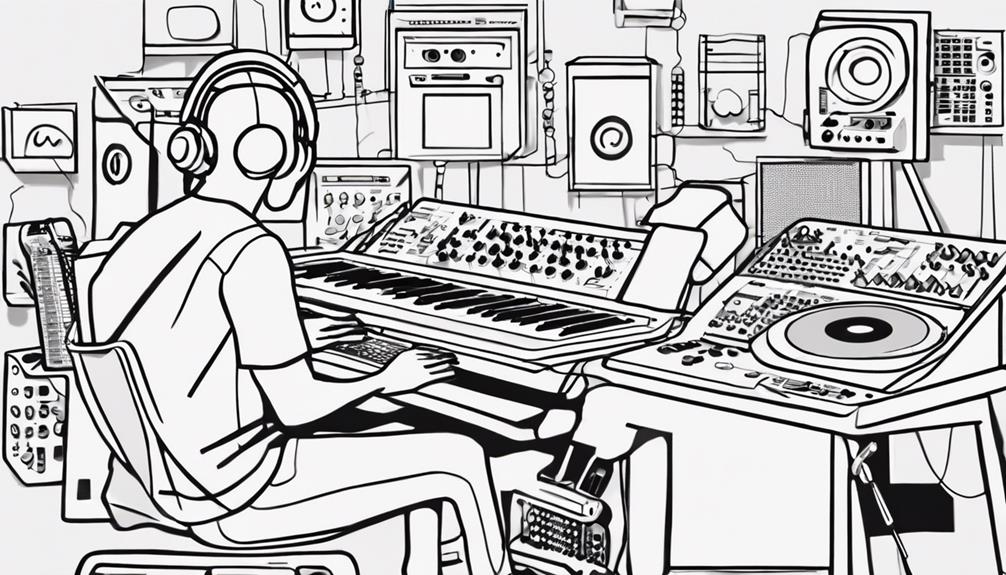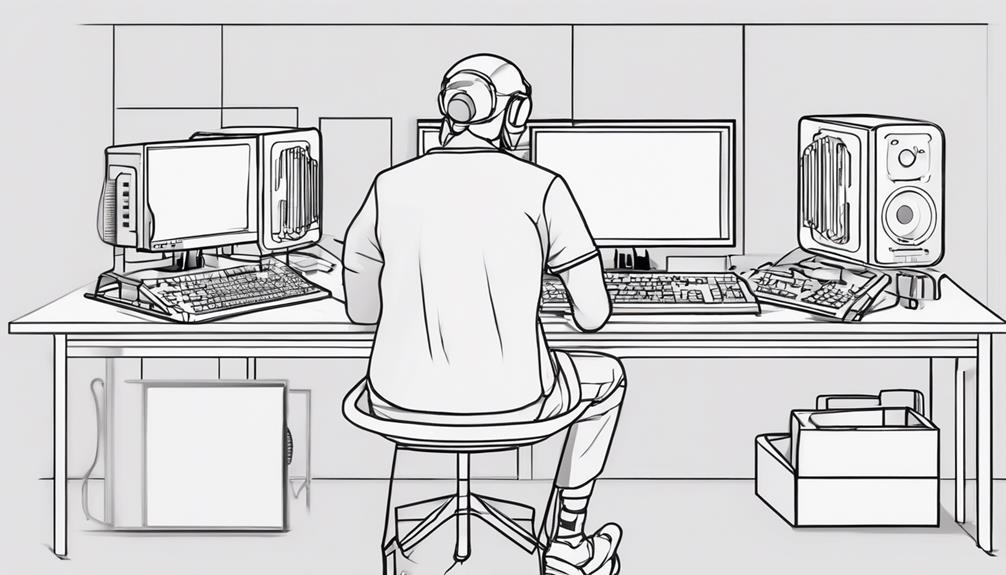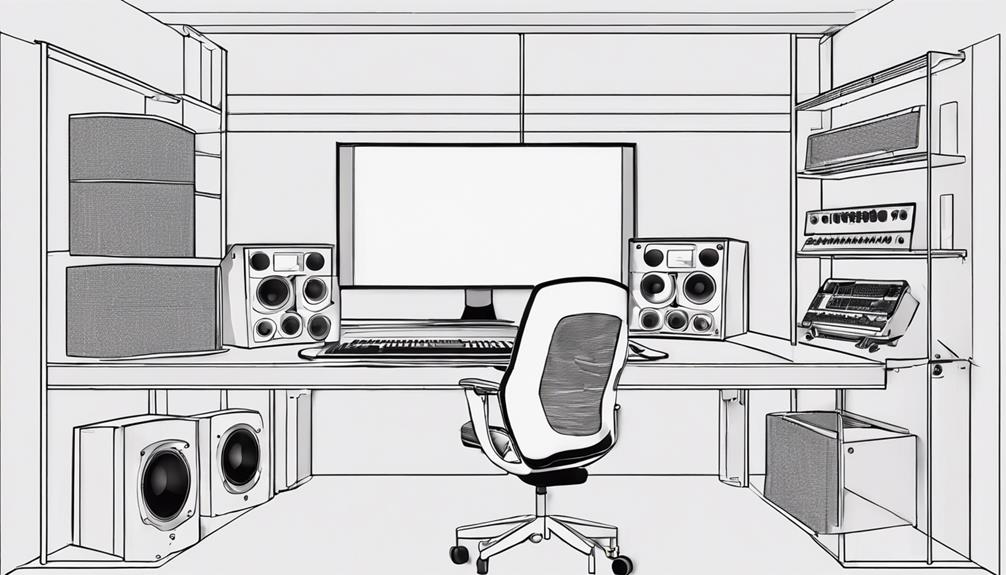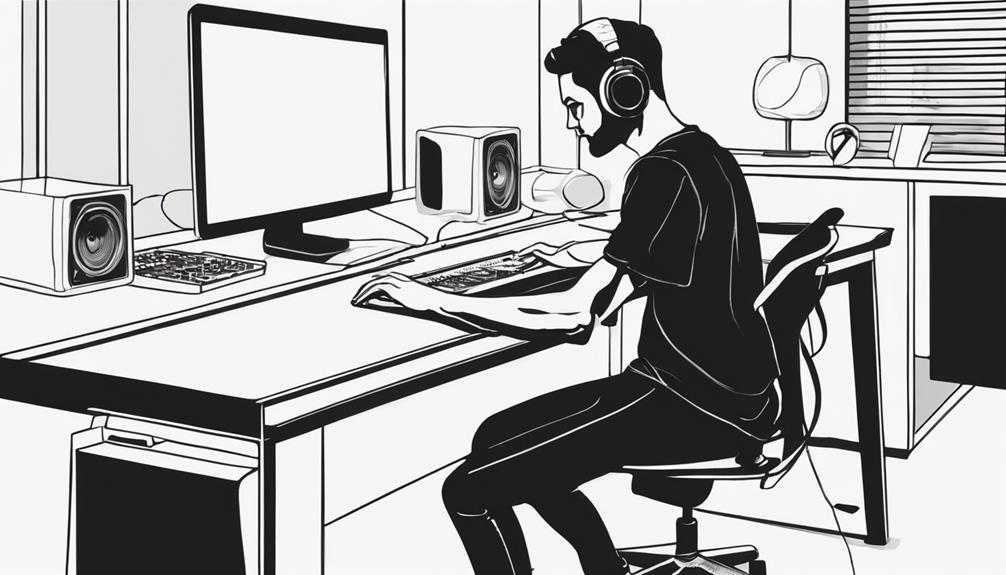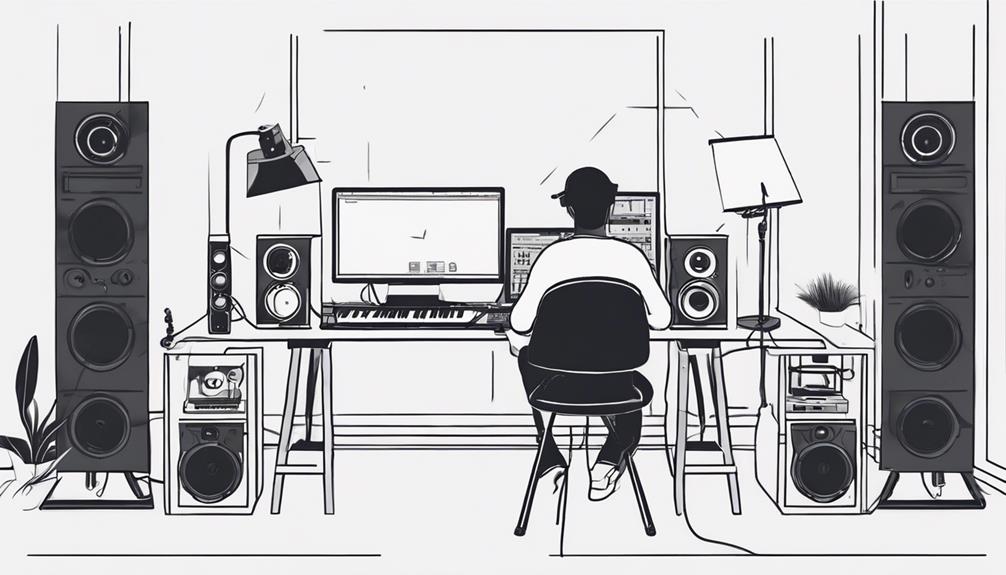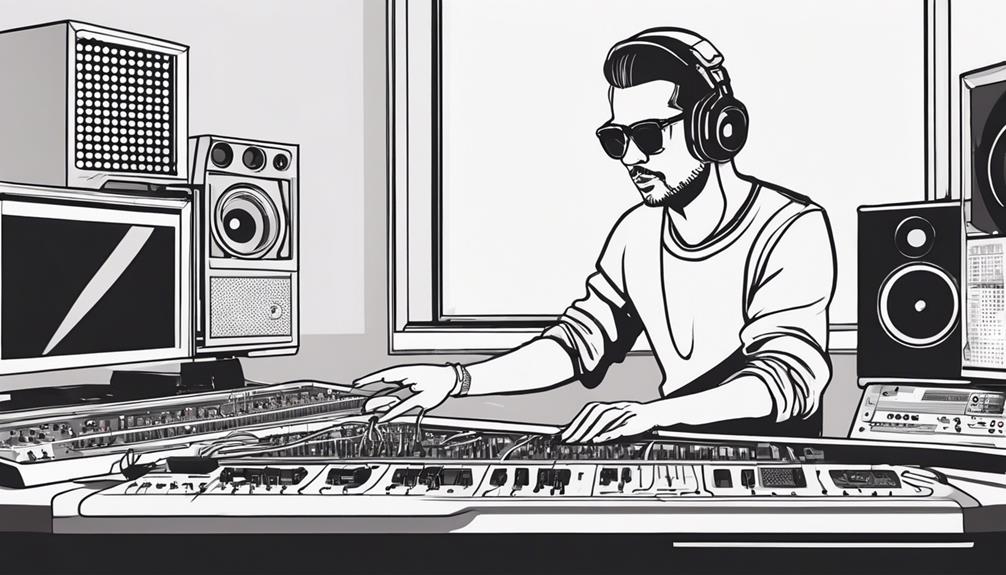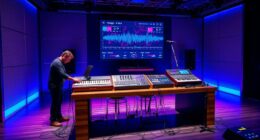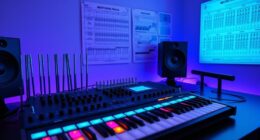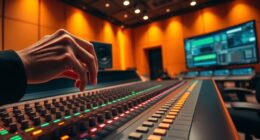Ready to begin your music production journey? Start by selecting essential software like Ableton Live or FL Studio. Develop a varied portfolio showcasing your talents and collaborate with other artists. Network at events and on social media to make industry connections. Learn the basics of music production, sound design, and mastering. Set up a home studio with key equipment and budget-friendly options. Practice regularly, experiment with new techniques, and stay updated on trends. Immerse yourself now and explore the world of music production!
Key Takeaways
- Learn music theory and master a DAW to understand production fundamentals.
- Experiment with various genres and styles to find your unique sound.
- Collaborate with other musicians and attend workshops to expand your network.
- Stay updated on industry trends and seek feedback to improve your skills.
- Practice regularly, study mixing principles, and aim for continuous improvement.
Essential Music Production Software
To break into music production, you must equip yourself with essential music production software. Examples include Ableton Live, Logic Pro, Pro Tools, FL Studio, and Studio One. These digital audio workstations (DAWs) are crucial tools for music producers as they offer features for recording, editing, mixing, and mastering music tracks.
Each software has its strengths. Ableton Live is favored for its intuitive workflow and live performance capabilities. Logic Pro stands out for its extensive library of virtual instruments and professional-grade mixing tools. Pro Tools is known for its advanced audio editing and post-production capabilities.
When setting up your home studio, consider investing in quality studio monitors to accurately hear your music. A MIDI controller provides hands-on control, and sound design plugins enhance your creativity. These production tools are essential for creating professional-sounding music and building a solid foundation for your music production journey.
Building Your Music Portfolio
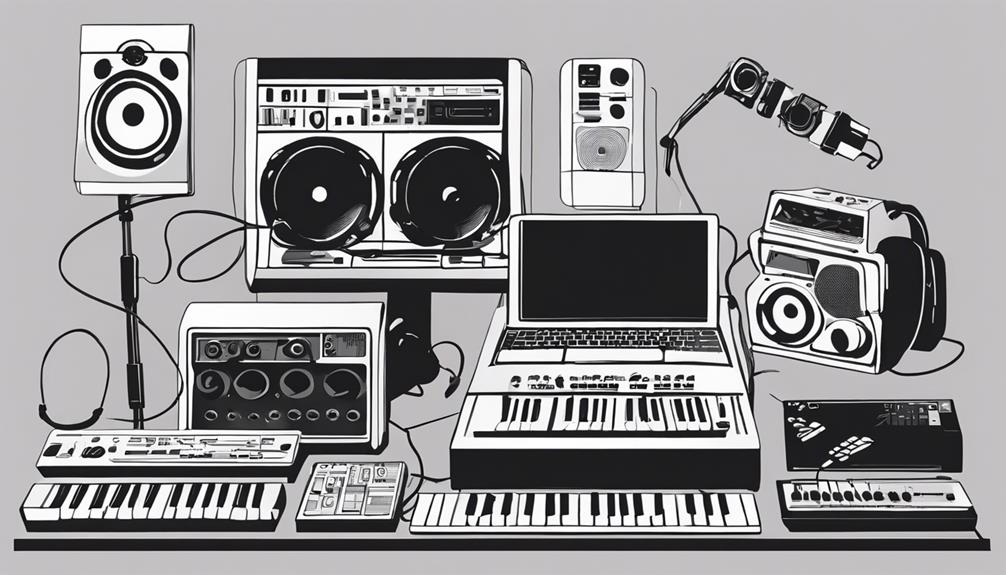
Craft a diverse and engaging music portfolio by showcasing a range of genres and styles in your projects. To make your portfolio stand out, consider the following tips:
- Showcase Variety: Include a mix of genres like pop, hip-hop, electronic, and rock to demonstrate your versatility in music production.
- Highlight Technical Skills: Feature audio samples that showcase your technical skills in production, mixing, and mastering to impress potential clients.
- Emphasize Collaborations: Display projects where you've collaborated with artists and musicians to show your ability to work in a team and produce high-quality music together.
Networking in the Music Industry

Networking plays a pivotal role in establishing connections and fostering opportunities within the music industry. Attending music industry events, conferences, and workshops provides valuable face-to-face interactions with industry professionals. These events offer a platform to meet like-minded individuals, potential collaborators, and mentors who can offer guidance and insights into the industry.
Additionally, utilizing social media platforms such as LinkedIn, SoundCloud, and Instagram allows you to connect with industry professionals, showcase your work, and stay updated on industry trends. Joining online forums, music production groups, and communities provides a space to network with peers, share experiences, and seek advice from seasoned professionals.
Building relationships with artists, producers, managers, and labels is essential for opening doors to collaborations, projects, and career advancements. By actively engaging in networking opportunities both in person and online, you can expand your network, gain valuable insights, and increase your chances of success in the competitive music industry.
Learning Music Production Basics
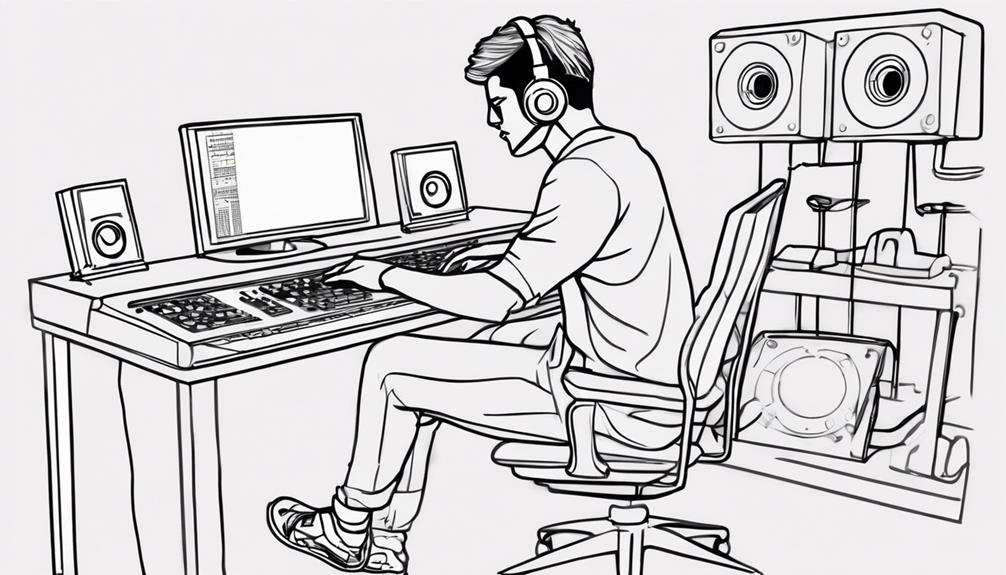
Begin your journey into music production by mastering the fundamentals of music theory, composition, and instrument proficiency. Immerse yourself in learning music production basics with these essential steps:
- Explore Essential Software: Familiarize yourself with Digital Audio Workstations (DAWs) like Ableton Live and Logic Pro to understand DAW features, plugins, and effects important for music production.
- Study Mixing and Mastering: Learn about mixing techniques to balance different tracks and instruments effectively. Delve into mastering processes to give your final productions a polished and professional sound.
- Enhance Your Skills: Develop sound synthesis knowledge, recording and editing music abilities, arranging tracks creatively, and audio manipulation skills to bring your musical ideas to life.
Mastering Sound Design
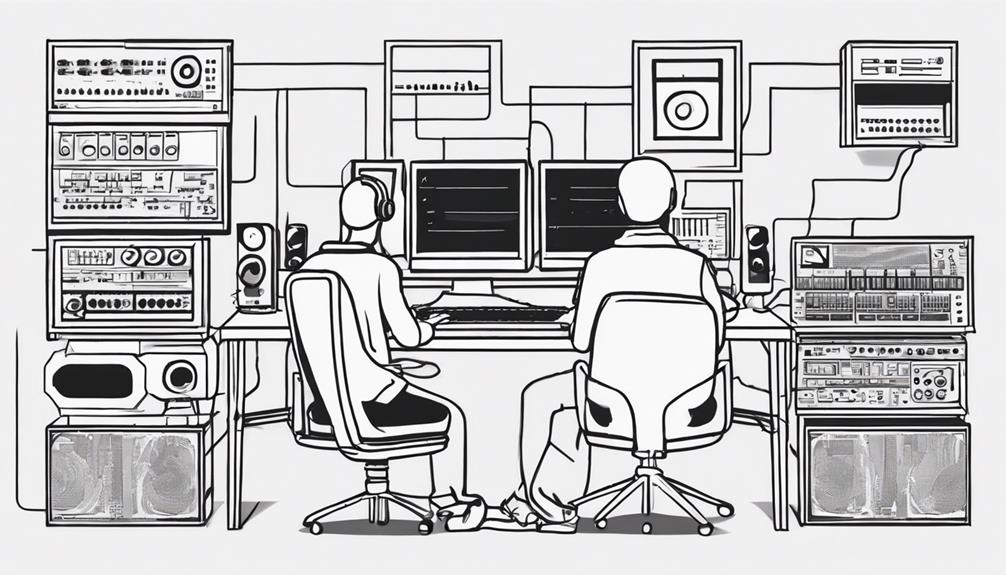
To master sound design in music production, explore the art of creating and manipulating audio elements to enhance the overall sonic experience. Sound design involves utilizing synthesizers, samples, and effects to craft unique sounds and textures that add depth and character to your music.
By understanding sound design principles and honing your skills in audio manipulation techniques, you can create immersive tracks that stand out in the industry.
Experimentation and creativity are key when mastering sound design. Dive deep into the world of synthesis, processing, and effects to discover new ways to shape the tone, texture, and atmosphere of your music.
Whether you're tweaking parameters on a synth or layering samples to create a rich sonic landscape, the possibilities for creating engaging sounds are endless.
Utilizing Samples and MIDI Tools
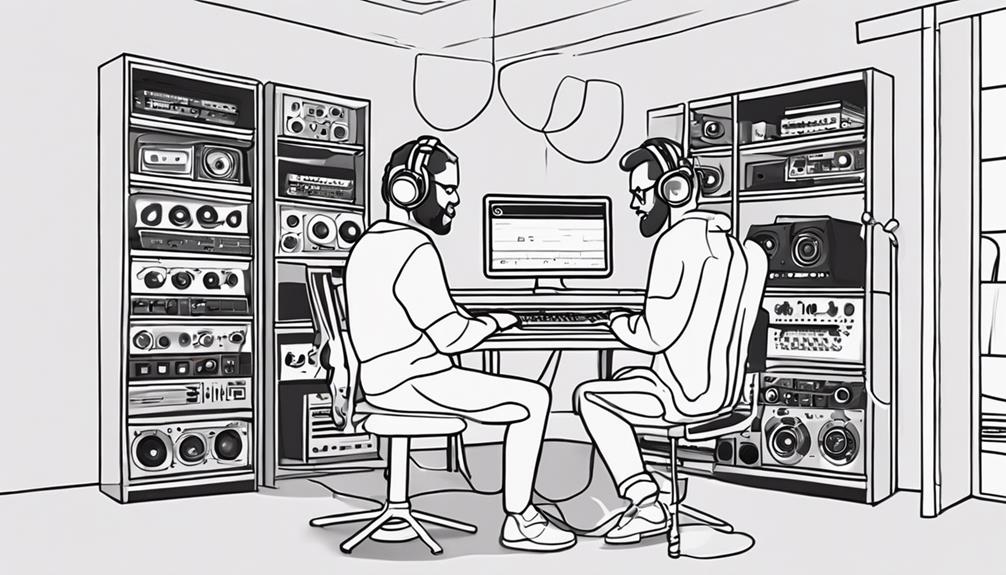
Mastering sound design in music production opens the door to effectively utilizing samples and MIDI tools to enhance your tracks and streamline your creative workflow.
When delving into the world of samples and MIDI tools in music production, consider the following:
- Enhancing Creativity: Samples and MIDI tools offer a vast array of sounds and musical elements that can inspire new ideas and help you break through creative blocks.
- Efficient Production: By manipulating samples and MIDI data in your DAW, you can compose, arrange, and produce music more efficiently, saving time and allowing for smoother workflow.
- Adding Unique Elements: Incorporating samples and MIDI tools into your projects can add unique textures, rhythms, and melodies that set your tracks apart and make them stand out in the music production landscape.
Exploring sample libraries and MIDI packs will provide you with a plethora of resources to experiment with and integrate into your music, enhancing both the quality and originality of your productions.
Music Production Equipment Essentials
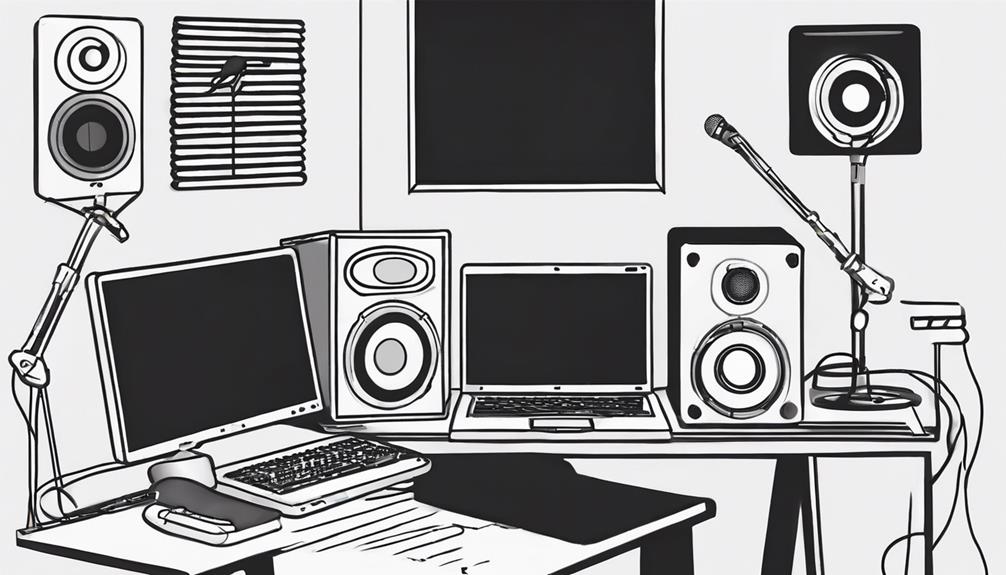
When setting up your music production arsenal, selecting essential gear like a computer, DAW software, and audio interface is key.
Enhance your home studio setup with quality microphones, MIDI keyboards, and studio furniture to create a comfortable workspace.
Consider budget-friendly options that still offer high-quality results in your music production journey.
Essential Gear Selection
Selecting the essential gear for music production is important for setting up a functional home studio. To kickstart your music production journey, here are three key pieces of equipment you need:
- Digital Audio Workstation (DAW): A DAW is the heart of your music production setup, allowing you to record, edit, and mix your tracks efficiently.
- Audio Interface: An audio interface connects your instruments and microphones to your computer, offering high-quality sound input and output for recording and monitoring.
- Quality Headphones: Good headphones are essential for precise audio monitoring and mixing, especially in situations where using studio monitors mightn't be possible.
When setting up your home studio, remember that a good microphone, MIDI controller for playing virtual instruments, studio headphones for detailed monitoring, and acoustic treatment to enhance sound quality are also important components to take into account.
Home Studio Setup
To establish an effective home studio for music production, make sure you have the necessary equipment, including a computer, digital audio workstation (DAW), audio interface, studio monitors, and headphones. Enhancing your setup with quality microphones, MIDI controllers, and instruments can elevate your music production experience. Investing in acoustic treatment for your studio space is essential to improve sound quality by reducing unwanted noise and reflections. Consider adding hardware synthesizers, drum machines, and audio effects units to expand your creative possibilities in music production. Building a comfortable and inspiring workspace with proper lighting, furniture, and storage can boost your productivity and creativity. Below is a table highlighting essential equipment for your home studio setup:
| Equipment | Description |
|---|---|
| DAW | Central software for recording and editing music |
| Studio Monitors | High-quality speakers for accurate sound reproduction |
| Headphones | Essential for detailed monitoring and mixing |
| Quality Microphones | Capture clear and professional audio recordings |
| MIDI Controllers | Interface for controlling virtual instruments and DAW |
Budget-Friendly Options
Considering budget-friendly options for essential music production equipment, you can kickstart your setup without compromising on quality. To get you started on the right track, here are three key items to contemplate:
- Entry-Level Audio Interfaces:
Look into options like the Focusrite Scarlett Solo or Behringer U-Phoria UM2. These provide the necessary connections for your instruments and microphones to interact with your computer seamlessly.
- Studio Headphones:
Opt for models such as the Audio-Technica ATH-M30x or Sony MDR7506 for quality sound reproduction at a reasonable price point. Good headphones are vital for detailed listening during the mixing and mastering process.
- Entry-Level Studio Monitors:
Consider investing in monitors like the Mackie CR Series or PreSonus Eris E3.5 for accurate sound representation. Having reliable studio monitors is essential for making informed decisions while working on your music production projects.
Frequently Asked Questions
How to Become a Music Producer With No Experience?
Want to become a music producer with no experience? Start by learning music theory, experimenting with production software, watching tutorials, reading books, taking courses, networking with industry pros, and interning at studios for hands-on experience.
Is It Too Late to Get Into Music Production?
It's never too late to immerse yourself in music production. Opportunities abound for those willing to learn, network, and persevere. With dedication and a passion for music, you can break into this field at any age.
What Is the Fastest Way to Learn Music Production?
Want to learn music production quickly? Immerse yourself in online courses, practice with a DAW, collaborate with pros, utilize tools like sample packs and plugins, and attend workshops. Engage, create, and grow rapidly!
Is It Hard to Get Into Music Production?
Getting into music production can be tough due to high competition, but dedication and skill-building are key. Stand out by developing a unique style. Many successful producers started small and worked their way up.
Conclusion
Now that you have all the tools and knowledge to immerse yourself in music production, it's time to delve into and start creating your own unique sound.
Imagine yourself in a dimly lit studio, surrounded by state-of-the-art equipment and endless possibilities.
The music industry is waiting for your talent and creativity, so don't hesitate to make your mark.
Start now and let your passion for music production shine through in every beat and melody you create. Start now and let your passion for music production shine through in every beat and melody you create. Take time to hone your craft, experiment with new sounds, and push the boundaries of creativity. If you’re wondering how to become a music producer, focus on sharpening your technical skills, building your own unique sound, and networking with other artists to grow your presence in the industry.

